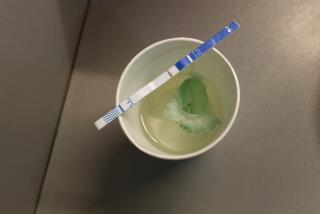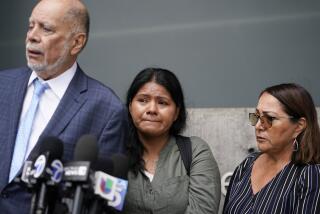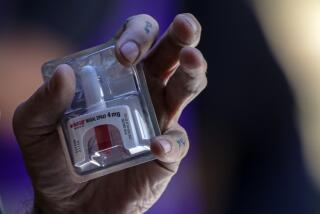L.A. students will be able to carry Narcan in schools under updated policy

Students will be able to carry Narcan, a nasal spray that can reverse an opioid overdose, in Los Angeles Unified schools under a soon-to-be-updated policy.
The move, announced to school board members in a message from Supt. Alberto M. Carvalho, comes amid continued alarm about the dangers of illicit fentanyl, a powerful synthetic opioid that has been consumed unknowingly by teens in counterfeit pills that look like Xanax or OxyContin.
Carvalho wrote to board members Tuesday that the Los Angeles County Department of Public Health “supports a clarification” in L.A. Unified policy “that would allow students to be able to carry Narcan in schools,” and that a policy bulletin was being updated and would be reissued shortly.
Narcan “cannot be used to get high, is not addictive and does not have any effect on a person if there are no opioids in their body,” Carvalho wrote to board members. Nor, he wrote, are there any “long-term consequences” from using it in emergency situations.
School district officials did not immediately provide additional information late Tuesday about the details of the policy update. The existing Los Angeles Unified policy on administering Narcan, issued in October, says that the medication “must be kept at the school in a secure location accessible to designated school personnel.”
Los Angeles Unified school board member Nick Melvoin expressed support for the policy update, saying in a statement that “Narcan has the power to save lives and I’ve been working to expand its access to everyone in our school communities, including students themselves.”
“But the increased use of Narcan as a life-saving measure underscores the drug crisis that’s being brought to our schools,” Melvoin said. “We must do more to address the root causes of this crisis and that starts with education and more support for our youth.”
Deadly overdoses have spiked among U.S. teens, even as illegal drug use has waned in that age group, researchers have found — the result of an increasingly dangerous drug supply. In Los Angeles County, 92% of teens who died of drug overdoses in 2021 tested positive for fentanyl, a county report found. Thirty-one youth died from fentanyl overdoses that year in L.A. County.
As deaths have risen, health researchers and advocates have urged greater access to naloxone, a medication that can reverse an opioid overdose and help someone start breathing again if administered promptly. The medication can be given by injection or through a nasal spray, which is commonly known by the brand name Narcan.
Expanding naloxone access and training could make a difference in teen deaths, experts say: Someone else was nearby in two-thirds of overdose deaths nationally among youth ages 10 to 19, “but most provided no overdose response,” according to a recent analysis by Centers for Disease Control and Prevention researchers.
In September, after a string of student overdoses, Los Angeles Unified announced that its schools would be stocked with naloxone and that staff were being trained to administer the nasal spray. The Los Angeles Unified policy on administering Narcan issued in October says its guidelines are for “administrators, school nurses and other trained personnel.”
Community groups have also held trainings on how to administer the nasal spray for students and families, but it was unclear whether trained students could carry it to school. The Times asked district representatives in December about whether students could do so.
At the time, an LAUSD spokesperson said that “if a parent requests their child bring naloxone, like any other medication on campus, there is a process for that request.” When asked repeatedly to explain that process, the spokesperson said that families should contact their schools for more information.
The decision to update and clarify the L.A. Unified policy was praised by advocates working to stop overdoses. Chelsea Shover, a UCLA researcher who has taught teens about naloxone, said that quick intervention is crucial during an overdose, and “having students carry it will really make a difference.”
“We know there will be times when teens are with their friends and not close to the nurse’s office,” Shover said. “If their friend has Narcan, their friend can save their life.”
With opioid overdoses showing no sign of abating, more regular citizens are carrying Narcan, the medication that can reverse the damaging effects of an overdose.
Naloxone works by attaching itself to the same receptors in the brain as opioids, blocking or reversing their effects. The National Institute on Drug Abuse says naloxone should be given to anyone who shows signs or is suspected of having overdosed and “there is no evidence of significant adverse reactions.”
As fentanyl has driven up overdose deaths, Los Angeles County health officials have pushed to get tens of thousands of boxes of Narcan into the hands of Angelenos, through community groups, county agencies, homeless outreach teams, and even free vending machines for people exiting county jails. CVS and Walgreens pharmacies offer it without a prescription, and many groups distribute it through a standing order from the state meant to ensure access to naloxone for people at risk of an opioid overdose or in a position to intervene during one.
To address ongoing concerns about fentanyl and other substances, Los Angeles Unified officials said that in February and March, schools will be offering online and in-person workshops to students and families on substance use issues, including how to talk to children about drugs and alcohol. The district has also rolled out peer-to-peer counseling and partnered with community groups, hospitals and educators to engage families in conversations about the issue, a spokesperson said.
“Through our existing initiatives, we will educate students and families about the safety and effectiveness of Narcan including the identification signs of an opioid overdose and the importance of alerting medical professionals when Narcan is used,” Carvalho wrote. “We remain committed to expanding access, education and training for this life-saving emergency medication.”
More to Read
Start your day right
Sign up for Essential California for news, features and recommendations from the L.A. Times and beyond in your inbox six days a week.
You may occasionally receive promotional content from the Los Angeles Times.








